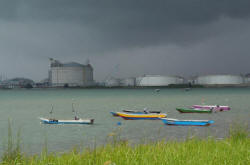Slowdowns in China and India eat away at Asian oil
demand
 Send a link to a friend
Send a link to a friend
 [August 15, 2018]
By Henning Gloystein [August 15, 2018]
By Henning Gloystein
SINGAPORE (Reuters) - Oil demand from
Asia's biggest importers, China and India, is growing more slowly than
expected, exposing weakness in two of the world's largest economies and
eroding a key pillar of global petroleum prices amid trade tensions.
The two countries buy a combined 12 percent of the world's oil, and
their growth has helped drive the recovery in oil prices since 2016.
Yet their shipped imports in July were about half a million barrels per
day (bpd) below their Jaunary-June average of 12.4 million bpd, shipping
data shows.
That has dragged down demand growth in Asia, despite inflated purchases
ahead of U.S. sanctions on Iran and increased imports from Japan and
South Korea as they struggle with record-setting heat waves.
Shipping data shows annualized growth in demand from Asia's five largest
oil importers - China, India, Japan, South Korea and Taiwan - fell from
more than 3.5 percent in 2016 to around 2 percent so far this year.

"Everything is weakening, but from a pretty elevated level," said Jeff
Brown, president of energy consultancy FGE.
Traders expect growth to slow further as the Iran sanctions take hold,
the trade spat between the United States and China escalates, and as
Asia's emerging markets show signs of cooling.
"Any further escalation in the trade conflict between them is clearly an
important downside risk and could lead to a further slowdown in oil
demand growth for 2019, leading to a downward pressure on oil prices,"
said Sushant Gupta, research director at energy consultancy Wood
Mackenzie.
Renewed U.S. sanctions against major oil exporter Iran, which from
November will target the petroleum sector, are expected to disrupt the
market.
Iran's oil exports peaked at almost 3 million bpd in May this year, but
they have since fallen to around 2 million bpd as Asian buyers,
including Japan, South Korea and India, began to shun its crude ahead of
the sanctions.
For a graphic on top Asian oil importers, click https://tmsnrt.rs/2KSQY3f
SLOW TO SHOW
The effects of the economic slowdown will take time to manifest, but
analysts say investors are already becoming cautious.
China's investment growth in the first seven months of the year slowed
to a record low of 5.5 percent, data showed this week.
Charters of super-tankers from the Middle East, on which Asia heavily
relies to meet its oil demand, are dipping, according to ship brokerage
Banchero Costa.

"If you look at pure economic figures, the impact of the tariff disputes
is still quite small, perhaps 0.5 percent of GDP growth. But the impact
on investment mood is starting to show," Brown said.
[to top of second column] |

Dark clouds pull up over
an oil storage terminal in Johor, Malaysia, November 7, 2017.
REUTERS/Henning Gloystein/File Photo

World trade volume growth peaked in January at almost 5.7 percent year-on-year,
but fell to less than 3 percent by May, according to the Netherlands Bureau for
Economic Policy Analysis.
Trade tensions with the U.S. have weakened currencies in emerging markets as
investors pull cash out of countries like India and China and convert it to U.S.
dollars, which are still seen as a safe haven.
Weaker currencies in Asia and tariff-suppressed trade slows economic growth,
reduces purchasing power, and eventually hits fuel demand.
Although Brent crude oil <LCOc1> has become about 8 percent more expensive this
year in dollars, the price increase has been 14 percent in China's renminbi <CNY=>
and more than 18 percent in Indian rupees <INR=>.
"The high crude prices appear to have been taking a toll on demand," said Sukrit
Vijayakar, Director of Indian oil consultancy Trifecta.
For a graphic on oil price change in different currencies, click https://tmsnrt.rs/2KOmTC1
JAPAN AND KOREA TO THE RESCUE?
Japan and South Korea, where summer consumption was bumped up by an unusual heat
wave, jointly imported around 6.3 million bpd of crude in July, compared with an
average of 6 million bpd in the first half of the year.

Australia, another rich economy in the region, has also seen strong demand,
importing an some 370,000 bpd in July, up from an average of 333,000 bpd in the
first half of the year.
But the increases matter little when weighed against China's tanker imports,
which fell from more than 8 million bpd during January and June to about 7.3
million bpd in July.
Shipping data suggests July oil imports into China, India, Japan, South Korea
and Taiwan were around 19 million bpd.
Although that's slightly above June, it's below the figures for April and May.
It's also some way off a record of more than 20 million bpd from April 2016.
Should the global economic outlook darken further amid trade disputes and
emerging market turmoil, oil demand in Asia could worsen.
"When you have all these factors like tariff disputes and weakening emerging
market currencies, it's going to hurt sentiment," said FGE's Brown.
(Reporting by Henning Gloystein; Editing by Gerry Doyle)
[© 2018 Thomson Reuters. All rights
reserved.] Copyright 2018 Reuters. All rights reserved. This material may not be published,
broadcast, rewritten or redistributed.
Thompson Reuters is solely responsible for this content. |